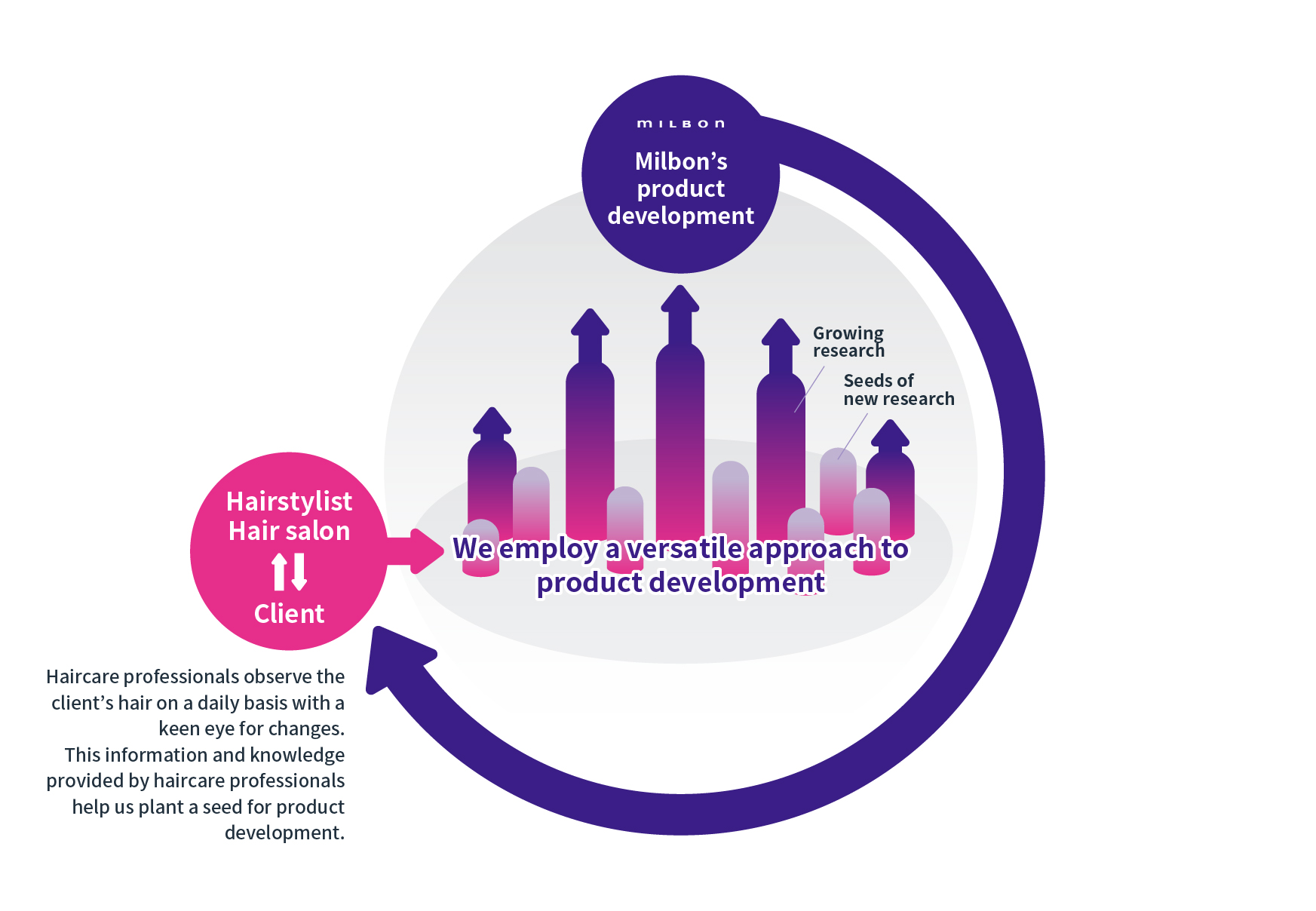NewTechnologies

We pioneer in new frontiers of beauty to inspire future customers not yet part of the Milbon family.
Driven by the transformation of society, we strive to always pioneer in the newest, most unexplored frontiers in order to exceed the evolving expectations of our customers and the advancing techniques of the field. At Milbon, we are engaged in advanced research laying the foundations for our product development. Milbon’s research covers extensive fields such as a structural analysis of hair and research into active ingredients, with an utmost priority on safety and environmental factors.
In realizing a system of timely product development through a versatile approach to the hair and scalp, we are actively partnering with various teams both within the Group and at external specialist research institutes, as well as haircare professionals.

The following section introduces innovative discoveries from our latest research, employing a versatile approach.
Observational Techniques
To fully capture the anatomy of a single strand of hair, with only 0.08 mm of diameter.
We took the first step toward cutting-edge hair research by looking into a single strand of hair; how does this strand change–both on the surface and inside–as a result of damage sustained in daily life and from salon treatments such as hair coloring? With a diameter of only 0.08mm, however, it is exceedingly difficult to capture the true form of each strand using standard observational methods.
To surpass this challenge, Milbon engage in research on the molecular level using SPring-8*, a large-scale synchrotron radiation facility.
High-precision hair observation technology using X-ray CT
Discovered linearly aligned cavities within the hair structure as a common damage phenomenon in people around the world.

Using SPring-8*, a large-scale synchrotron radiation facility producing the world's highest level of synchrotron radiation, Milbon conducted 3D X-ray CT imaging of hair from countries and regions around the world.
Analyzing the findings, we discovered the existence of SSVs – Stick-Shaped Voids, a common damage phenomenon in people around the world that forms in damaged hair and contributes to causing split ends and breakage.
Further research at the nano-level and development of advanced technologies brought on another breakthrough: Micro SSVs, microcavities inside the hair even finer than SSVs. We discovered that these Micro SSVs expand and link together as damage progresses, and could gradually transform into SSVs in the absence of effective treatment
SPring-8: A large-scale synchrotron radiation facility located in Harima Science Garden City, Hyogo Prefecture. The facility is owned and managed by RIKEN, Japan’s leading physical and chemical research institute. The name "SPring-8" is derived from Super Photon ring-8 GeV (8 GeV, or 8 giga electron volts, the energy in the electron beam circulating in the storage ring). Synchrotron radiation is a powerful electromagnetic wave generated when electrons are accelerated to almost the speed of light toward a path bent by electromagnets. SPring-8 uses this type of radiation to conduct various scientific research, including nanotechnology and biotechnology, as well as industrial applications. (http://www.spring8.or.jp/ja/about_us/whats_sp8/)
Scalp Flora Research
Rigorous research on “Scalp Flora” and the scalp microbiome to uncover the mechanisms for maintaining a healthy scalp
Scalp Flora(Microbial Flora of the Scalp): Among the bacteria existing in the human body, and those commonly observed in most people, the bacterial genera found on the scalp surface are collectively called the Scalp Flora.
A study of the relationship between chronic scalp inflammation and Scalp Flora balance
Discovery revealing associations between Scalp Flora and hair loss, thinning, and graying
With the knowledge that people suffering from chronic scalp inflammation are more prone to increased hair loss, thinning, and graying, we shifted our focus to how changes in Scalp Flora cause these symptoms.
With the aim to uncover this phenomenon, we conducted joint research with TAK-Circulator, a venture company established through collaborations between institutions at the University of Tokyo.
This research revealed excess count for Corynebacterium, a bacteria found in Scalp Flora, in women with chronic scalp inflammation. Our findings revealed the associations between Scalp Flora and hair loss, thinning, and graying, marking a breakthrough discovery in the field.
In addition, we succeeded in discovering an ingredient that helps establish an optimal balance of Scalp Flora. This ingredient has been shown to inhibit chronic inflammation of the scalp and is also effective in suppressing hair loss and hair graying.
Big Data Analysis
To take on the unanswered questions of hair and the scalp, we are committed to collecting and analyzing big data.To take on the unanswered questions of hair and the scalp, we are committed to collecting and analyzing big data.
Hair and the scalp remain a largely unexplored field, with a smaller body of research compared to that of the skin and other similar areas. For this reason, Milbon has taken the initiative to collect versatile data on hair and the scalp as well as on changes over time through a multi-round survey of thousands of people from their 20s to their 70s over a long period of time and analyzing the fundamental structure of hair.
Applying our accumulated knowledge, we recently developed a digital device* that can collect a wide variety of data about the scalp. With the cooperation of salons across Japan, we utilize tens of thousands of simplified data and questionnaire surveys to collect information on customer behavior and treatment history.
Analyzed changes in scalp before and after the advent of the with-COVID era based on approximately 30,000 data.
What changes did the COVID-19 pandemic have on the scalp? We conducted an extensive study and analysis on this topic facilitated with the kind cooperation of salons across Japan.
Lifestyles have undergone dramatic changes as a result of the COVID-19 pandemic, with prolonged mask wearing, voluntary isolation at home, and more. Despite the frequent reports of skin problems caused by excess humidity inside masks, there has been limited progress in the scientific research of the scalp.
In an effort to facilitate further research, Milbon obtained and accumulated scalp data from 34,678 female customers with the cooperation of salons across all 47 prefectures in Japan.



